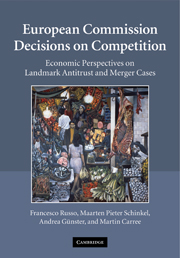 European Commission Decisions on Competition
European Commission Decisions on Competition Book contents
- Frontmatter
- Contents
- List of figures
- List of tables
- List of abbreviations
- Table of legislation
- Table of equivalences
- Acknowledgments
- 1 Introduction
- 2 Horizontal restrictions
- 3 Abuse of dominance
- 4 Licensing
- 5 Vertical restrictions
- 6 Joint ventures and alliances
- 7 Restrictions to competition by Member States
- 8 Mergers and acquisitions
- Annex I Decisions related to procedural issues
- Annex II Table of landmark decisions described in the book
- Annex III Table of mergers blocked by the European Commission in chronological order
- Annex IV Table of landmark merger decisions described in the book in alphabetical order
- Annex V Table of antitrust decisions in alphabetical order
- Bibliography
- Index
5 - Vertical restrictions
Published online by Cambridge University Press: 04 August 2010
- Frontmatter
- Contents
- List of figures
- List of tables
- List of abbreviations
- Table of legislation
- Table of equivalences
- Acknowledgments
- 1 Introduction
- 2 Horizontal restrictions
- 3 Abuse of dominance
- 4 Licensing
- 5 Vertical restrictions
- 6 Joint ventures and alliances
- 7 Restrictions to competition by Member States
- 8 Mergers and acquisitions
- Annex I Decisions related to procedural issues
- Annex II Table of landmark decisions described in the book
- Annex III Table of mergers blocked by the European Commission in chronological order
- Annex IV Table of landmark merger decisions described in the book in alphabetical order
- Annex V Table of antitrust decisions in alphabetical order
- Bibliography
- Index
Summary
Introduction
Vertical agreements are concluded between companies at different levels of the supply chain. They are widely used when there are frequent vertical business interactions. Few firms produce inhouse all their required inputs and are active in all stages of the production process, up to and including the specialised distribution of the final goods and services. Vertical agreements between independent firms can often create cost efficiencies, enhanced production efficiency, or an improved allocation of products on the market. In particular, they can help prevent double mark-ups, free-riding among either producers or retailers, and the promotion of investments in service and the certification of quality. Vertical agreements are therefore common and efficient in many production chains.
Vertical agreements may, however, also restrain trade and so have anticompetitive effects. The imposition of maximum prices, for example, may protect downstream market power. Vertical restraints are also known to restrict entry for new competitors – for instance, by preventing access to distributors – and reduce either intrabrand or interbrand competition, or both. These anticompetitive effects of vertical agreements are discussed in the literature and have been identified by competition authorities including the European Commission.
To assess the possible anticompetitive effects of vertical agreements properly, it is important to understand the type and degree of competition at all relevant levels of the production chain. Indeed, the restrictive effects of vertical restraints are typically produced horizontally from one layer of production to another.
- Type
- Chapter
- Information
- European Commission Decisions on CompetitionEconomic Perspectives on Landmark Antitrust and Merger Cases, pp. 218 - 269Publisher: Cambridge University PressPrint publication year: 2010


